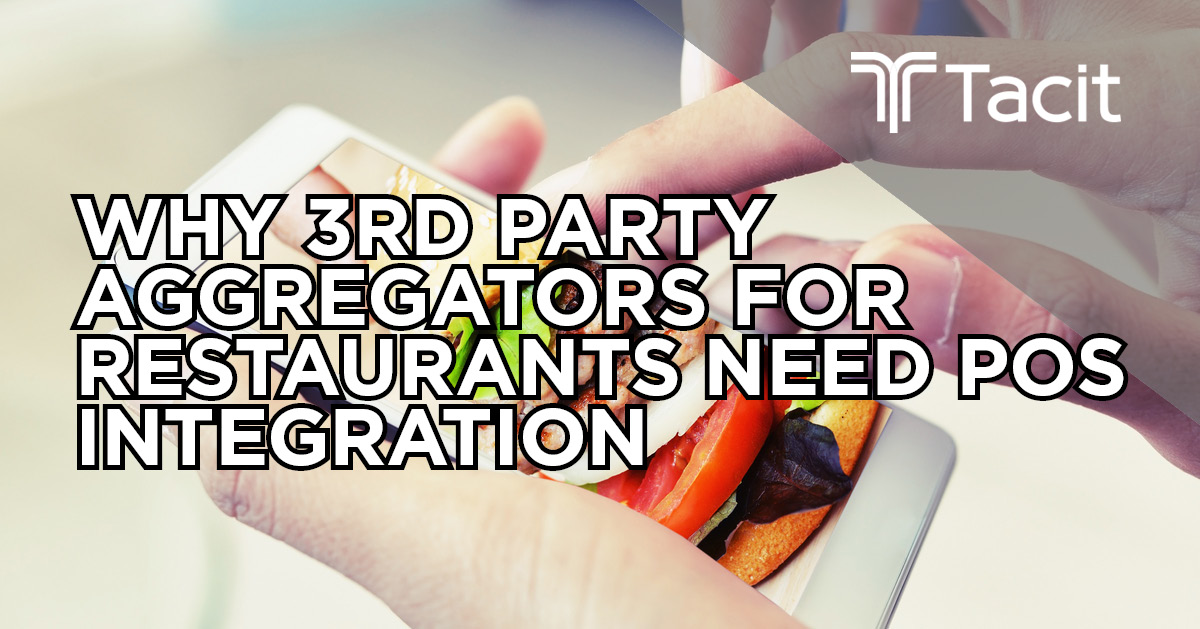
13 Aug Why 3rd Party Aggregators for Restaurants Need Point of Sale System Integration to Pay Off
Restaurants were believed to be immune from digitization. Yet, even as Amazon became a behemoth, restaurants felt their own presence begin to ebb as the “Uberization of industries” took hold. Now, restaurants face the prospects of omnichannel service. According to PYMNTS.com, 3rd party aggregators, including Uber Eats, Grub Hub and Door Dash, continue to drive a wedge between restaurants and their customers. Customers may be loyal to the marketplace, the aggregator but not necessarily your brand. However, unintegrated 3rd party aggregators know how troublesome their software can be, especially for restaurants that are living in Tablet Hell, and their only hope lies in integration with point of sale (POS) systems.
What’s Wrong With 3rd Party Aggregators for Restaurants?
The problem with 3rd party aggregators for restaurants derives from a common issue. The software was designed to support front end and back-office functions, but they were not necessarily intended to integrate with a company’s existing POS system. Today’s restaurants lose countless dollars due to errors in rekeying orders sent from 3rd party aggregators, and franchises realize unexpected results of 3rd-party relationships and business partnerships. Individual franchisees may under-report sales, reducing their royalty fees. Also, third-party delivery apps‘ essential functions were to connect consumers with the restaurant directly, and if the restaurant keeps a single app open on a single tablet, that amounts to one tablet in use per aggregator for each location. Now, using a tablet is not a big deal, but it increases the work of managing a restaurant. What happens if the tablet updates and does not restart in the morning? What if customers or even employees arrive to pick up an order you haven’t seen it? What if it is left unplugged for an extended period? The answers to those questions have something in common; the restaurant loses out on business sent from the 3rd party aggregators.
POS System Integration Holds the Key to Escaping Tablet Hell
3rd party aggregators for restaurants have seen pushback from the industry following this creation of “tablet hell.” Restaurants are working to develop their native, branded delivery capabilities, and many will succeed. Of course, this poses a risk for aggregators that already charge a commission of up to 30% for each delivery order, excluding the delivery fee itself. Ultimately, some restaurants will choose to leave 3rd-party marketplaces, and those that stay will expect an easy, painless, and mindless use of the system.
Restaurant operators want it all to function on its own and not be forced to rekey errors or send errors manually to the kitchen. In other words, the 3rd party aggregator apps must be integrated with the POS system to streamline the entire operation. Another troubling fact exists. While 3rd party aggregators for restaurants account for only 3% of restaurant orders, delivery could rise to become 40% of all restaurant orders within the next few years, reports Restaurant Dive. Failure to integrate will effectively put these aggregators, and restaurant operators, out of business.
Benefits of Integrated POS and 3rd Party Systems
Integrated POS and 3rd party aggregators for restaurants offer significant benefits, including:
- Increased visibility into restaurant operations and costs.
- Improved reporting capabilities, leveraging the advanced functions of POS systems to run reports on aggregator-derived data.
- Reduced stress of managing multiple apps and tablets, improving the workflow within the restaurant.
- Lower labor costs, resulting from workers that are engaged with customers or working to prepare food.
- Decreased equipment and insurance costs.
- Streamlined order entry, which enables handling of delivery orders during peak hours and throughout the day.
- Fewer errors when preparing meals, providing the best experience, and service possible.
Leverage the Experience of a Proven Integrator to Unlock the Real Value of 3rd Party Relationships
The aggregators are not going away, but they are turning their attention to integrated restaurant systems. Those that do not integrate will find themselves pushed out of the partnership. That is hypothetical at this point, but one thing is clear, restaurant operators need integration. Aggregators need integration. Together, the integration will lower the costs of working with aggregators and help restaurants survive thinning profit margins. Find out how to get started with integration in your organization by contacting Tacit online today.

Pingback:The Exponential Added Costs of 3rd Party Restaurant Aggregators Without POS Integration
Posted at 13:08h, 04 August[…] from the 3rd party aggregator, including suspension of access to the […]
Pingback:The Rise of Mobile App Ordering Reduces Need for Interfacing With Staff
Posted at 14:47h, 04 August[…] With all the discussion over profitability within the restaurant industry, it is easy to assume third-party aggregator partnerships only add to costs. However, refined management of the restaurant through integration […]
Pingback:Decrease Franchisee Under Reporting With Digital Ordering & POS Integration
Posted at 14:49h, 04 August[…] data regarding third-party delivery. Third-party aggregators generate more data for your organization, but this data loses value when left […]
Pingback:How to Be an Omnichannel Restaurant Operator Without Decreasing EBITDA
Posted at 14:49h, 04 August[…] including takeout, drive-through, dine-in, delivery through branded apps, and delivery through third-party aggregator services, such as Uber Eats. Unfortunately, the path to the successful omnichannel operator is not […]
Pingback:Omnichannel Integrated Food Ordering Platforms: How to Reduce Tablets
Posted at 14:50h, 04 August[…] 0 Digital Ordering Omnichannel Ordering Restaurant Operations Third Party […]